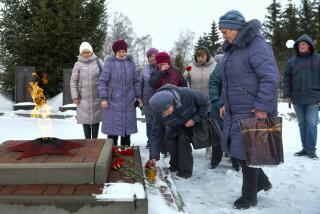At Least 26 Die in 2 Siberian Air Crashes; Russia’s 1994 Toll Up to 287 : Safety: Officials had been reassuring fliers about airlines that split off from former Soviet carrier.
MOSCOW — At least 26 people were killed in two separate weekend airplane crashes in Siberia, authorities said Sunday, heightening concern over safety on Russia’s newly privatized airlines.
The crashes Saturday brought the number of people killed in Russian air disasters this year to at least 287, compared with 221 deaths in all of 1993.
“The state has lost control over the situation,” an officer of the Transportation Ministry’s aviation department said Sunday. “Privatizing Aeroflot (the former Soviet state carrier) was a colossal stupidity.”
The two accidents came just as Russian and U.S. officials were reassuring frightened fliers that air safety was improving after a disastrous record in the past three years.
In one infamous catastrophe, tapes from a “black box,” or flight recorder, revealed that an Aeroflot pilot’s teen-age son was at the controls of a European-made Airbus 310 when it went into a tailspin and crashed in Novokuznetsk in March, killing 75 people. Expatriates have taken to calling Aeroflot “Scare-oflot” or “Aero-plop.”
But in a sign of reviving confidence, the U.S. government lifted a ban earlier this month on federal employees traveling on Russian airlines.
In July, the State Department had warned citizens of the hazards of flying here now that Aeroflot has broken up into about 320 different national and regional airlines. U.S. government employees were instructed to stay off these “Baby-flots” except in case of emergency. At an Oct. 14 news conference, U.S. Ambassador Thomas R. Pickering rescinded that ban, announcing that a thorough review by about 30 Russian and 25 U.S. aviation experts had given Russia “minimally passing marks” for air safety oversight.
The experts’ report, however, warned that “immediate steps must be taken to avoid slippage into unacceptable levels.”
U.S. government employees are now permitted to travel on Russian carriers that are certified to operate internationally, meaning they must meet a higher safety standard than other Russian carriers.
Embassy officials could not say Sunday whether Yakutavia and Aeronika, the airlines involved in Saturday’s crashes, were on the list of U.S.-approved carriers. But the Transportation Ministry spokesman said the airlines were not accredited for international travel.
In the first crash, an Aeronika Antonov 12 flying from Sakhalin in the Russian Far East bound for Yermolino in the European part of Russia crashed as it was trying to land for refueling in Ust-Ilimsk, about 385 miles north of Irkutsk.
The plane burst into flames about a mile from the runway and crashed into a mountain, killing all 21 people aboard, according to the Ministry for Emergency Situations.
The plane was carrying 12 tons of fish products and four automobiles, the Interfax news agency reported, raising the possibility that overloading was to blame.
A report by the Russian Interstate Aviation Committee’s flight safety commission earlier this year noted that “frequent cases of carrying unregistered passengers and/or cargo have lately become the most widespread violation revealed during nearly every air accident investigation.”
In some cases, ground personnel have reportedly taken bribes in exchange for allowing stowaways or extra cargo onto a plane--sometimes without informing the pilot of the cargo’s true weight.
But the committee’s chairwoman, Tatyana G. Anodina, said that officials have been cracking down on overloading and that violations have decreased this year. Anodina said her agency does not verify the loading practices for non-Russian carriers.
The second crash Saturday involved a small AN-2 plane owned by Yakutavia that burst into flames during a crash-landing in the remote village of Batagay in the autonomous republic of Yakut-Sakha. Five people were killed, including one child, and nine were injured, officials said Sunday. Details of the crash were not immediately available.
More to Read
Sign up for Essential California
The most important California stories and recommendations in your inbox every morning.
You may occasionally receive promotional content from the Los Angeles Times.










